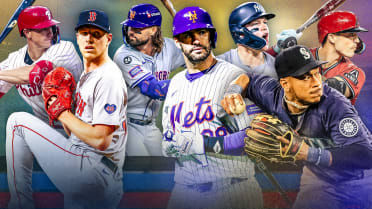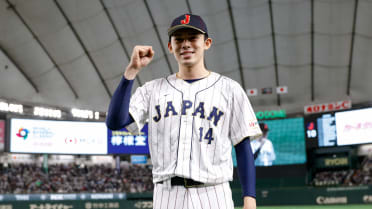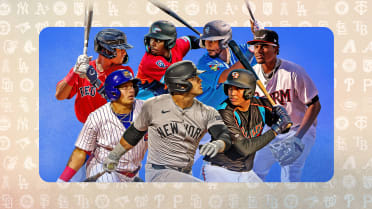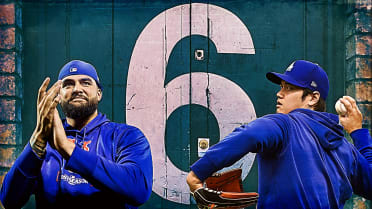Rays riding new horses in bullpen 'Stable'
ST. PETERSBURG -- When a player is cut from Major League Spring Training, it often makes for an awkward conversation. There can be a mix of disappointment and frustration, sometimes sadness and anger, before acceptance and determination set in.
That wasn’t the case for Louis Head, though.
When the Rays sent Head out of big league camp this spring, manager Kevin Cash said, the right-handed reliever didn’t show even a hint of disappointment.
“He said, ‘I was going to be selling solar panels if I wasn't here,’” Cash recalled.
Indeed, Head was a door-to-door salesman in Arizona, nearly ready to call it a career, when the Rays called him. Left-hander Dietrich Enns thought he might be nearing the end of his playing days, too, before the Rays plucked him out of independent ball last summer. Righty JT Chargois had similar doubts about his future until the Mariners -- his only suitor -- offered a non-roster deal before Spring Training.
But there they were in the Rays’ bullpen earlier this week.
Head has been lights out between Triple-A and the Majors, with a sub-2.00 ERA at each level. Enns earned a spot with his excellent performance as a starter in Durham. Chargois hasn’t allowed a hit in three outings since Tampa Bay traded for him.
These are individual success stories, of course, triumphs of personal perseverance. They are also professional scouting success stories, examples of the lengths to which the Rays will go to uncover the talent and depth necessary to sustain their high level of pitching performance.
“That’s always rewarding from a scouting perspective,” said Kevin Ibach, the Rays’ senior director of pro personnel and pro scouting. “As much time as we all spend on the road and all over the country seeing these guys, certainly when some of those guys you see end up in Rays uniforms and have success, it’s definitely rewarding for all the work that we put in.”
The work has been necessary lately, too, with all the injury-related turnover in Tampa Bay’s bullpen. As bullpen coach Stan Boroski said, “Guys are getting to know each other almost on a daily basis.”
The Rays are without the three relievers -- Nick Anderson (right elbow ligament tear), Pete Fairbanks (right shoulder inflammation) and Diego Castillo (traded) -- who pushed them deep into the postseason last year. Fellow key relievers J.P. Feyereisen, Ryan Thompson, Collin McHugh and Jeffrey Springs are among the Rays’ 15 pitchers on the injured list, a number that would strain the depth of any staff.
Some of them should be back at some point this season, with McHugh likely the first to return this weekend in Baltimore. In the meantime, the Rays are plugging along as ever.
They’ve had 20 different pitchers make at least 10 appearances. Eight different pitchers have recorded a save; two of them have since been traded, and three are on the 10-day IL. Their bullpen has put together a 1.49 ERA in the past 24 games and an American League-best 3.00 ERA overall this season.
“It’s crazy seeing when you’ve got essentially your main throwers go down … and you trade Diego, and it’s a whole new pitching staff aside from [Andrew Kittredge], who has been there the whole season,” starter Josh Fleming said. “But they’re doing a great job. They’re still ‘the Stable’ that they were last year.”
Same Stable, different horses. Look at the pitchers in the bullpen Wednesday afternoon during the Rays’ win over the Mariners at Tropicana Field -- and consider where they came from.
• Enns, a 30-year-old lefty with two big league games to his name, who was pitching and coaching for an independent ball team in Joliet, Ill., when the Rays signed him to a Minor League deal last summer. He had a 2.44 ERA with 75 strikeouts over 59 innings in Triple-A when the Rays called him up.
• Head, who spent nine seasons in the Minors waiting for the Major League promotion that finally came on his 31st birthday and contemplated hanging up his cleats while selling solar panels.
• Chargois, a 30-year-old acquired in a deal with the Mariners headlined by Castillo’s departure. Chargois pitched in Japan last season and had a 4.58 ERA over 85 appearances in the Majors before emerging more than a month into this season as a non-roster revelation with the Mariners.
• DJ Johnson, a 31-year-old right-hander who signed with the Rays in 2010 as a non-drafted free agent for, as he said, “$1,000 and a plane ticket.” He’d been released by three teams, spent a season in Japan and posted a 4.66 ERA in the Majors before Tampa Bay picked him up from Cleveland last week. He struck out two over two clean innings in his first two appearances with Tampa Bay.
• Matt Wisler, a 28-year-old right-hander who has been traded five times, claimed off waivers once and designated for assignment by the Giants in June. Since joining the Rays on June 11, Wisler has put together a 2.13 ERA with 33 strikeouts in 25 1/3 innings while using his slider 91% of the time.
• Ryan Sherriff, a 31-year-old lefty who was a 28th-round pick by the Cardinals in 2011. He broke through with 10 scoreless outings for the Rays last season. Sherriff stepped away from the game earlier this year to focus on his mental health, and he has recorded some important outs -- with one save -- for Tampa Bay over the past week.
• Drew Rasmussen, a 26-year-old righty who has followed a more traditional path since being an unsigned Rays first-round Draft pick in 2017. He worked his way through the Brewers’ system and eventually to Tampa Bay’s bullpen after joining the Rays in May alongside Feyereisen in the Willy Adames trade.
• Kittredge, a 31-year-old righty who avoided Tommy John surgery after suffering a sprained UCL last August and has emerged this season as perhaps the most unexpected member of the Rays’ All-Star trio. The bullpen’s steady star has pitched in every inning from the first to the 11th while recording a 1.40 ERA in 51 1/3 innings. He ranks sixth on the Rays with 1.9 bWAR.
Of course, getting the most out of previously unheralded pitchers is nothing new for the Rays. But how do they go about finding the Enns and Heads of the world, pitchers seemingly on the brink of the industry? How do they identify talent where others seem to miss it?
“Nothing our front office does surprises me. They find guys wherever they can. They're really good at it,” Boroski said. “I think the things that we emphasize might be just a tad different than other people. And when you see good stuff and then use it the most efficient way possible, it usually works.”
Ibach credited the Rays’ “wonderful” pitching group, including pitching coach Kyle Snyder and Boroski, as well as the club’s commitment to scouting -- giving the Rays the resources to employ a sizable staff spread around the country -- as well their scouts’ work ethic and lack of ego.
Whether it’s the scouts who grind through 100-degree afternoons watching Complex League games, scout Mike Brown going to watch a Minor League reliever-turned-solar panel salesman throw a bullpen session or Ibach himself sitting in the stands for the independent league game where he rediscovered Enns, the Rays put in the time and effort to keep “the Stable” full.
“They do a really good job. They work really hard,” Cash said. “It's not the most appreciated job all the time, what they have to go through to find and sit on these guys and watch them. And then we run it upstairs and see if the scouts’ view is matching maybe the R&D view. And when it comes together, it's a big reward for everybody.”
Senior Reporter Adam Berry covers the Rays for MLB.com and covered the Pirates from 2015-21.




